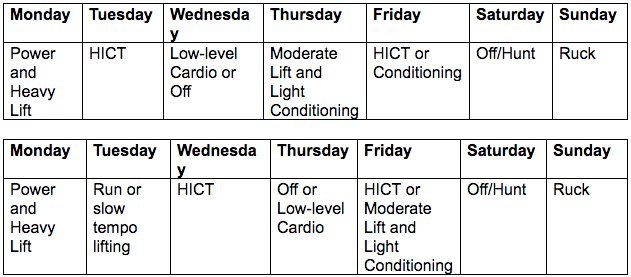In part one of this series, I outlined what High-Intensity Continuous (HICT) step-ups are, why they’re important for hunters, and how to do them. We’ll use part two to talk in-depth about performing sets of HICT step-ups and how to fit them into a hunt fitness training program.
How to Start and How to Progress
Typically, I start folks off with one set of ten minutes and work up from there. But if someone is out of shape, I’ll start with a five- to seven-minute set. Progression happens in two ways—by adding time and weight. While prepping for my 2019 Alaska and Wyoming hunts, I worked up to doing one, heavy set of fifteen-minutes early in the week, with the absolute maximum amount of weight on my back, and later in the week, I’d do two twenty-minute sets, with a five-minute break in between, with a slightly less than maximum weight on my back. (Maximum meaning that I couldn’t have increased my pace beyond one rep every four to five seconds, and slightly less than maximum meaning I likely could have done one rep every three to four seconds.)
Start with one set of five to ten minutes with a weight that maintains the one rep every four to five-second cycle. As that gets easier, which will likely happen quickly, add weight—ten pounds or so. After that first increase, then you can start adding time—two to five minutes. Cycle adding weight and time, working up to a twenty-minute set. Once you’re there, you can start the two-day per week method I mentioned above.

HICT: Where and When
We’ll handle the questions of where? and when? in two ways—where in the scope of your training week and when throughout the year should you include HICT in your training plan. Let’s start with the year and work backward.
HICT fits throughout the training year. Start using it early in the off-season before putting miles in on the trail and continue to use it into the spring and summer. Do HICT step-ups for four to six weeks at a time, then take a break for three to four weeks. While on break, transition to putting more miles in on the trail, using that newfound endurance you’ve gained.
In my own training, I start with a block in January, then take a break and increase my rucking with my pack, bring HICT back in April, then get back to rucking, bring HICT back again in July, and then ruck more. (Aside: The rucking is always there, it’s the amount that increases or decreases.) Depending on where and when I’m hunting, I might fit one more cycle into my training before I go. This year, I head out for Alaska in mid-September, so I might hit one more, two-week cycle at the end of August before shipping off.
Where in the training week depends on whether or not you want to fit in one or two sessions. If you’re doing one session, place it directly after your hardest training day of the week. That could be a weight training session that puts you in the trash can, a long run, or an ass-kicker of a hike. HICT, while improving aerobic capacity of fast-twitch muscles, also improves recovery from other intense exercises.
If you’re fancying two HICT sessions per week, place one early to mid-week and one at the end—Tuesday/Friday and Wednesday/Friday work well. I do my heavy HICT sessions on Tuesdays or Wednesdays after a lift or run on the previous day, and my longer duration HICT sessions on Fridays before setting off on my weekend hiking and hunting excursions. Below are two potential weekly training set-ups that include HICT.
What Else Should You be Doing on the Days You do HICT Step-ups?
The short answer is, not much. On the days that you’re doing HICT, it should be the focus. You could throw in a few, light weight lifting exercises or calisthenics drills beforehand as a warm-up, but that’s about it.
You can, however, add in HICT training for your upper body on the days that you’re doing the step-ups. I’ve done this with great results. The problem is—it sucks. I use exercises like modified push-ups (your hands are elevated off the ground on a bar or a bench), inverted rows, and sled rows—push-ups being the nastiest of the bunch. I fit the upper-body HICT in on both of my step-up sessions. Please, ease your way into adding in the upper-body work. Start with short duration sets of five minutes and build up to ten minutes. It doesn’t sound like much, but doing one push-up every five seconds is no joke. Don’t be a hero.
HICT Step-ups: A Hidden Benefit
Beyond developing our fast-twitch muscles, HICT step-ups prep us for heavy pack work without overly stressing our bodies. A big mistake that a lot of hunters make is hiking too often, and too far, with too heavy of a pack. Walking over uneven ground with heavy loads for an extended period of time is going to wreak havoc on the back, hips, ankles, and knees. And it isn’t necessary. You can use HICT to prep your body for heavy packing without all of the unnecessary stress.
Last year, I worked up to 100 pounds in my pack for 15-minute sets while accumulating a lot of miles on the trail with no more than 40 pounds in my pack. The combination prepared me for pack-ins and outs by acclimating my body to the heavy loads while getting in a high volume of pack time that wasn’t too stressful for my body. Packing heavy too frequently, and for too many miles, is going to break your body down more than it will build it up. Consistently hitting HICT step-ups with a heavy weight in your pack, and contrasting that with lighter load hikes, will prep you to handle loads of meat and camp supplies when the time comes.
Side note: Know your pack in and out situation and plan for it. For example, I’ll be hunting moose in Alaska this year. We’ll have a nice base camp and boats, so our pack-outs won’t be excessively long—two miles at the most. Considering that, I will do a couple of one- to two-mile hikes with 100 pounds or so on my back to acclimate. But, I won’t be doing that all the time. Just enough to teach my body what it feels like when the time comes. Then I’ll leave it alone until it’s time to pack a bull back to camp.
Conclusion
For hunting endurance, we need to train our body to use oxygen as efficiently as possible. Just doing a bunch of endless, unfocused step-ups won’t do that. But HICT step-ups will. Grab your box, load up your pack, and get to stepping. You’ll be glad you did when you head up a mountain this fall.
Bio
Todd Bumgardner, MS is an author, coach, and outdoorsman. He’s a performance coach for a Tier 1 tactical unit while also co-owning a gym (Beyond Strength Performance NOVA) and a mentorship program for coaches and trainers called Strength Faction. He splits his time between Northern Virginia and Central Pennsylvania, and when he’s not either of those places, he’s traveling to hunt or fish.





